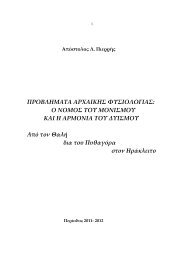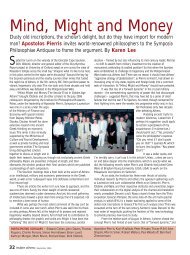chapter 10 the monism of darkness and the dualism of limit and ...
chapter 10 the monism of darkness and the dualism of limit and ...
chapter 10 the monism of darkness and the dualism of limit and ...
Create successful ePaper yourself
Turn your PDF publications into a flip-book with our unique Google optimized e-Paper software.
MONISM OF DARKNESS - DUALISM OF LIMIT AND INDETERMINACY 115<br />
hemispheres <strong>of</strong> <strong>the</strong> world, <strong>the</strong> one being bright (full <strong>of</strong> fire) <strong>and</strong> <strong>the</strong> o<strong>the</strong>r<br />
dark (full <strong>of</strong> air), as it is articulated by Empedocles A 30 <strong>and</strong> 56 DK. Night<br />
is <strong>the</strong> airy hemisphere which is periodically illuminated by reflection from<br />
<strong>the</strong> empyreal hemisphere upon <strong>the</strong> Earth; <strong>the</strong> reflection is projected as Sun<br />
<strong>and</strong> constitutes Day; periodicity depends on <strong>the</strong> inclination <strong>of</strong> <strong>the</strong> poles<br />
<strong>and</strong> <strong>of</strong> <strong>the</strong> axis <strong>of</strong> cosmic revolution. In Hesiod <strong>the</strong> pattern is more<br />
elementary: Erebos is <strong>the</strong> Tartarean Darkness below <strong>the</strong> Earth, from which<br />
Night comes <strong>and</strong> covers <strong>the</strong> luminous Ae<strong>the</strong>r <strong>of</strong> <strong>the</strong> upper boundaries <strong>of</strong><br />
<strong>the</strong> World. (The Night dwells in Erebos; Euripides, Orestres 174-6. Varro<br />
regards her as daughter <strong>of</strong> Erebos (Festus, de verborum significatione V, s.v.<br />
Erebum where a verse is also quoted: Erebo creata fuscis crinibus Nox, te<br />
invoco. She is called Nox Erebeis, Culex 202. A st<strong>and</strong>ing characteristic<br />
expression is NfÍ âÚ‚ÂÓÓ‹ Ilias Θ 488, Opera et Dies 17 etc.). The water<br />
<strong>of</strong> Styx springs from <strong>the</strong> Ocean <strong>and</strong> flows under <strong>the</strong> earth passing through<br />
Night, that is to say through <strong>the</strong> lowest Tartarean place, Theogony 785<br />
sqq.:<br />
≈‰ˆÚ<br />
„˘¯ÚfiÓ, ¬ Ù’ âÎ apple¤ÙÚ˘ ηٷÏ›‚ÂÙ·È äÏÈ‚¿ÙÔÈÔ<br />
ñ„ËÏɘ, appleÔÏÏeÓ ‰b ñapplee ¯ıÔÓe˜ ÂéÚ˘Ô‰Â›Ë˜<br />
âÍ îÂÚÔÜ appleÔÙ·ÌÔÖÔ Ú¤ÂÈ ‰Èa Ó‡ÎÙ· ̤ϷÈÓ·Ó<br />
\øηÓÔÖÔ Î¤Ú·˜Ø ‰ÂοÙË ‰’ âappled ÌÔÖÚ· ‰¤‰·ÛÙ·È.<br />
The Orphic Rhapsodies agree with <strong>the</strong> relatively subdued position <strong>of</strong> Night<br />
in Hesiod’s ontological pyramid, but <strong>the</strong>y link her organically with <strong>the</strong> sole<br />
chain <strong>of</strong> succession that Orphism accepts, as one <strong>of</strong> its main rings. They<br />
regard <strong>the</strong> Hesiodic Chaos as equivalent to primordial Darkness but <strong>the</strong>y<br />
also subordinate it to Time <strong>and</strong> exempt it from <strong>the</strong> progressional line <strong>of</strong><br />
reality. The cosmic Egg is engendered by Chronos = Time in Ae<strong>the</strong>r OF 70;<br />
cf. supra on birth-in. The First-Born=Phaethon=Phanes (who flew upwards<br />
after breaking <strong>the</strong> Egg to <strong>the</strong> Ae<strong>the</strong>r <strong>and</strong> <strong>the</strong> aerial Gap, OF 72) is<br />
considered to be <strong>the</strong> son only <strong>of</strong> Ae<strong>the</strong>r, OF 73-74, cf. 75. Chaos<br />
encompasses <strong>the</strong> World but is not essentially involved in <strong>the</strong> World’s genetic<br />
constitution, nor has it any well-defined cosmogonic role, but only a precise<br />
cosmological position, cf. Hesiod, Theogony 807 sqq. esp. 814.<br />
52. Housman’s emendation <strong>of</strong> <strong>the</strong> manuscript reading astra. The Great Bear<br />
does not set (does not sink into <strong>the</strong> Ocean) in <strong>the</strong> situation <strong>of</strong> <strong>the</strong> present<br />
World-Order. Repetent is Rutgers emendation <strong>of</strong> repetens.<br />
53. After v. 829 <strong>the</strong>re is a lacuna in <strong>the</strong> text’s tradition. The famous <strong>and</strong><br />
controversial codex Carrionis (C), now lost, had <strong>the</strong> following complement<br />
in <strong>the</strong> margin:










